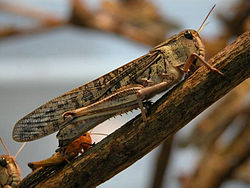Migratory locust
The migratory locust (Locusta migratoria) is the most widespread locust species, and the only species in the genus Locusta. It occurs throughout Africa, Asia, Australia and New Zealand. It used to be common in Europe but has now become rare there.
| Migratory locust | |
|---|---|

| |
| Female migratory locust | |
| Scientific classification | |
| Kingdom: | |
| Phylum: | |
| Class: | |
| Order: | |
| Suborder: | |
| Family: | |
| Genus: | Locusta
|
| Binomial name | |
| Locusta migratoria (Linnaeus, 1758)
| |
Because of the vast geographic area it occupies, which comprises many different ecological zones, numerous subspecies have been described. However, not all experts agree on the validity of some of these subspecies.
Many other species of Orthoptera with gregarious and migratory behavior are indicated with the name of 'locusts'.
Polyphenism
The migratory locust is polyphenic. It has a solitary phase and a gregarious phase. This is a type of polymorphism where a single genotype produces two or more phenotypes. During development, an environmental factor causes a switch from one morph to another.
For the migratory locust, the switch is caused by population density. As the density of the population increases the locust transforms from the solitary phase to the gregarious phase, with intermediate phases.
The colour and size of the migratory locust changes according to its phase and its age. Gregarious larvae have a yellow to orange covering with black spots. Solitary larvae are green or brown. The gregarious adult is brownish with yellow, the latter colour becoming more intense and extensive on maturation. The solitary adult is brown with varying extent of green colour depending on the colour of the vegetation. Gregarious adults vary in size between 40 and 60 mm according to the sex. They are smaller than the solitary adults.
- Steedman, Alison (ed) 1988. Locust Handbook. 2nd ed, London: Overseas Development Natural Resources Institute.
Migratory Locust Media
Close-Up of a Locusta migratoria


